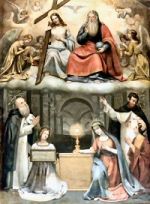The Father William Most Collection
Muratorian Canon
[New Catholic Encyclopedia]
Discovered by L. A. *Muratori in the Ambrosian Library at Milan in 1740, the Muratorian fragment is the oldest known canon of the NT. The Milan copy, which seems to have come from Bobbio, is hardly older than 8th century. Mutilated at both ends, it contains 85 lines. Four fragments, probably of the 11th and 12th centuries, were found at Monte Cassino.
The date of composition is clear from lines 74-77: "Very recently [nuperrime], in our times. Hermas wrote the Shepherd, when his brother, Bishop Pius, was sitting in the chair of the Church of the City of Rome' (see HERMAS, SHEPHERD OF). The pontificate of Pius I was about A.D. 142 -155.
The poor Latin suggests that the original was Greek. Also, the neuter plural subject with singular verb (alia plura . . . recipi non potest: lines 65-67) is normal in Greek, but barbarous in Latin. Most of the literature of the Roman Church at this time was in Greek. Yet Latin also had begun to be used by the end of the 2d century, and there were at that time Latin translations of at least part of Scripture. Moreover, the play on words in lines 67-68, fel cum melle misceri non congruit, could not be made in Greek. Perhaps the translator substituted a current Latin saying for a different original.
It is uncertain who composed this canon. Clement of Alexandria, Melito of Sardes, Polycrates of Ephesus, Pope Victor, Pope St. Zephryinus, and St. Hippolytus have been suggested as possible authors. The last, the first antipope, is the most favored. From the way it speaks of the city, the canon seems to have been written at Rome. It uses a tone of authority, which would accord with one who claimed to be pope; e.g., it says firmly that some works attributed to St. Paul "cannot be received in the Catholic Church," and, "We receive only the Apocalypses of John and Peter." Moreover, the canon strongly argues, against the Roman priest Caius, that St. John the Apostle wrote both the fourth Gospel and the Apocalypse. The arguments used are thought to come from Hippolytus. M. J. Lagrange [RevBibl 42 (1933) 182] cites Denys bar-Salihi, a 12th-century Syrian: "Hippolytus says that John, writing ... 13 Epistles, wrote them to seven churches" (cf. lines 48-50 of the canon). Yet these arguments are not conclusive; the author might be merely citing general belief, or decisions of authority. Nor would Hippolytus have used a tone of authority before c. 217, when he laid claim to the papacy. But that was not soon after the papacy of Pius I (cf. lines 74-77). For the contents, see BIBLE, III ( CANON ), 3.
Bibliography: Quasten Patr 2:207-210. Altaner 158-160. H. LECLERCQ, DACL 12.1: 543-560. M. J. LAGRANGE, Histoire ancienne du Canon du N.T., pt. 1, Introduction à l'étude du N.T. (pts. 1, 2, 4, Paris 1933-37); "L'Auteur du Canon de Muratori," RevBibl 35 ( 1926) 83-88 "Le Canon d'Hippolyte et le Fragment de Muratori," RevBibl 42 (1933) 161-186. Illustration credit: Biblioteca Ambrosiana, Milan.






